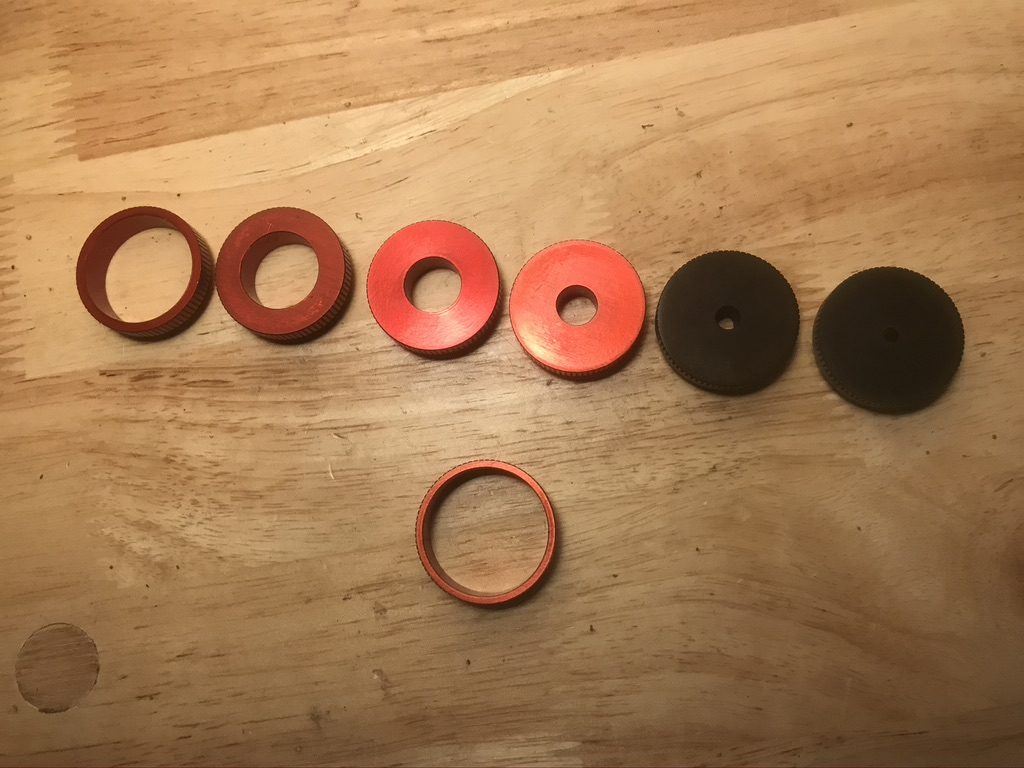
I came across a very interesting product from PhotoEscape, Inc. It is a set of six aperture rings plus one ring to rule them all which works as a “rubber band ring” (click the link to learn more and read the excellent Dr. Norman Wong’s article). Intrigued, I ordered a set and here are my observations.
First of all, the quality of the rings is pretty good, the threads are clean and cut well. The finish could be a bit better, there were a few clear metal spots where the anodizing die did not stick, but this is just a cosmetic issue, I don’t really care about how good they look, as long as they do the job.
I only have two Ultradot Matchdot II scopes, the rest of my red dots are Aimpoint Micro-form factor sights (SIG Romeo, TRS-25, Swampfox, etc). The set came with no instructions at all, so I figured I will just try to mount the rings on my Ultradot and see which one fits which side (Ultradots have different threads for the front and read ends of the tube).
The “rubber band ring” went to the front end, and the aperture ring thread matched the one on the rear. But it didn’t make a lot of sense to me, so I sent an email to PhotoEscape asking for clarification. The answer came almost immediately (thanks, Alex, for the fast response!) and, as I suspected, it was exactly the opposite of what I thought.
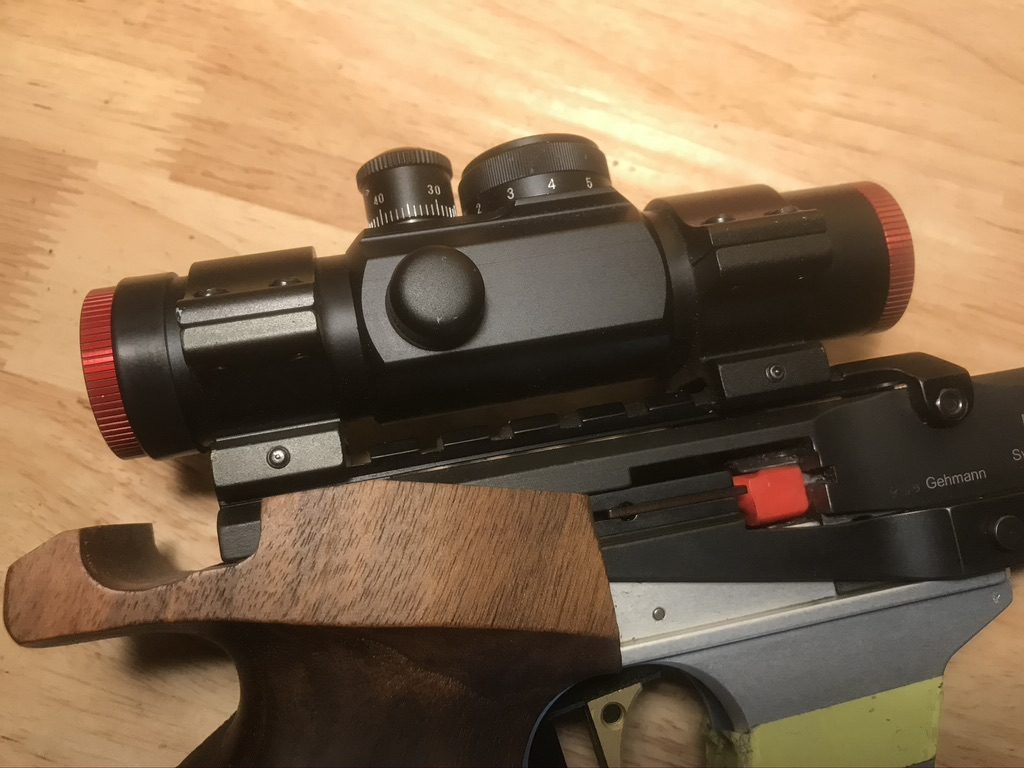
As it turns out, the aperture ring has to be mounted in the front, and Ultradots come with thin black adapter ring. As a hoarder collector (!!!), I save all packages from my equipment, so it only took an hour to find the original UD box in my storage, and lo and behold, that thin black ring was there, still in its plastic wrap.
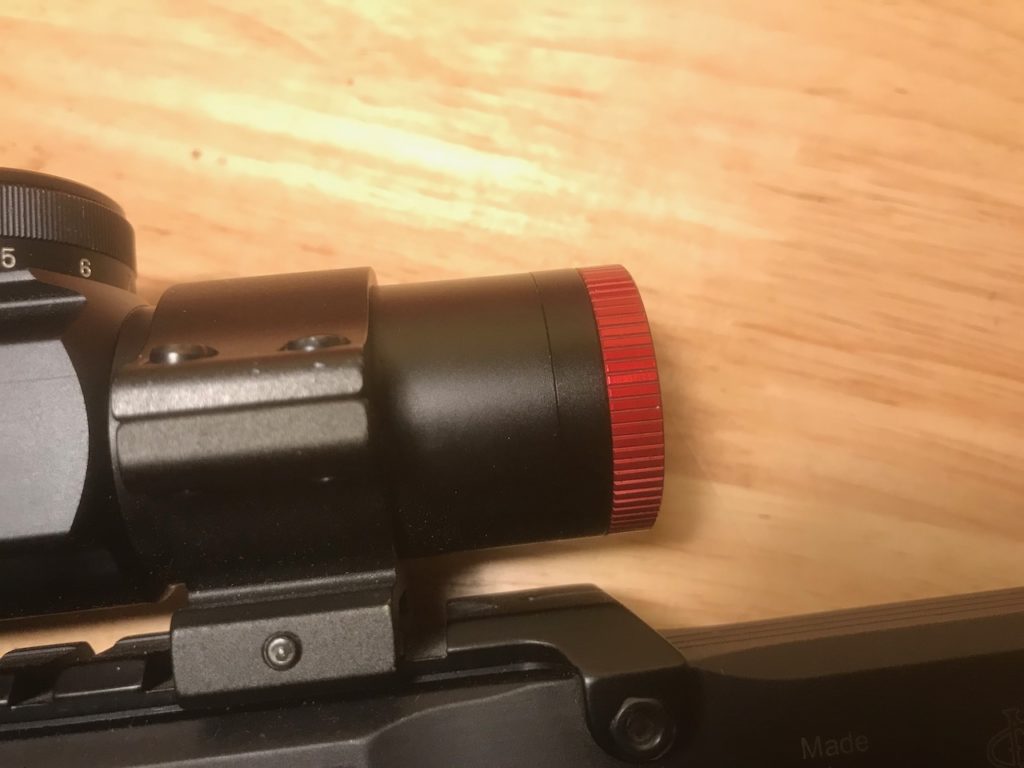
The rear ring experience was a bit different – there were no adapters to mount it to the rear end of the tube. But the aperture ring #1 has almost the same opening as the rubber band ring, if not just slightly smaller, so I used it instead.
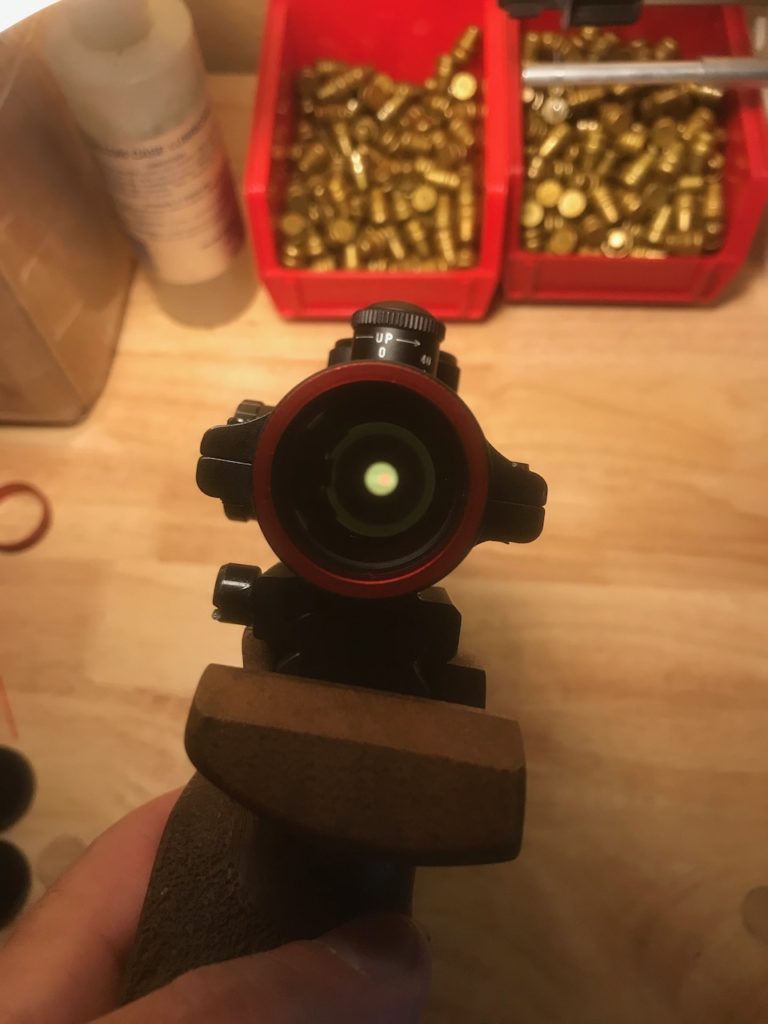
Range Time
As Alex warned me, a single trip to the range is not enough – and I agree completely. So these are just my initial observations, of course, the testing will continue.
All shooting was done at 25 yards, using reduced slow fire targets. At the first opportunity I will repeat the test with 50 yards targets. The lighting conditions were pretty good initially (our firing line is facing East, and it was 5pm, so the setting sun was right behind me and the target was well lit), but the sun was down soon and we switched the range lights on.
I started with aperture ring #4 (the rings are not numbered or marked in any way – #4 is the fourth one from the left on the top picture).
I was able to see the black target bull’s eye immediately, and a some white around it (about one more scoring ring), it created some kind of a tunnel vision with ring within the ring within the ring and a dot in the middle… wait, no, it was not in the middle! So I had to start making small corrections to my hold, wrist angle, grip, and initially it was a bit difficult, but somehow I got used to it.
After my third slow fire string my scores were 95, 95 and 96!!! Usually my scores vary from 88 on a bad day to 92 on a good day, so this was a very pleasant surprise!
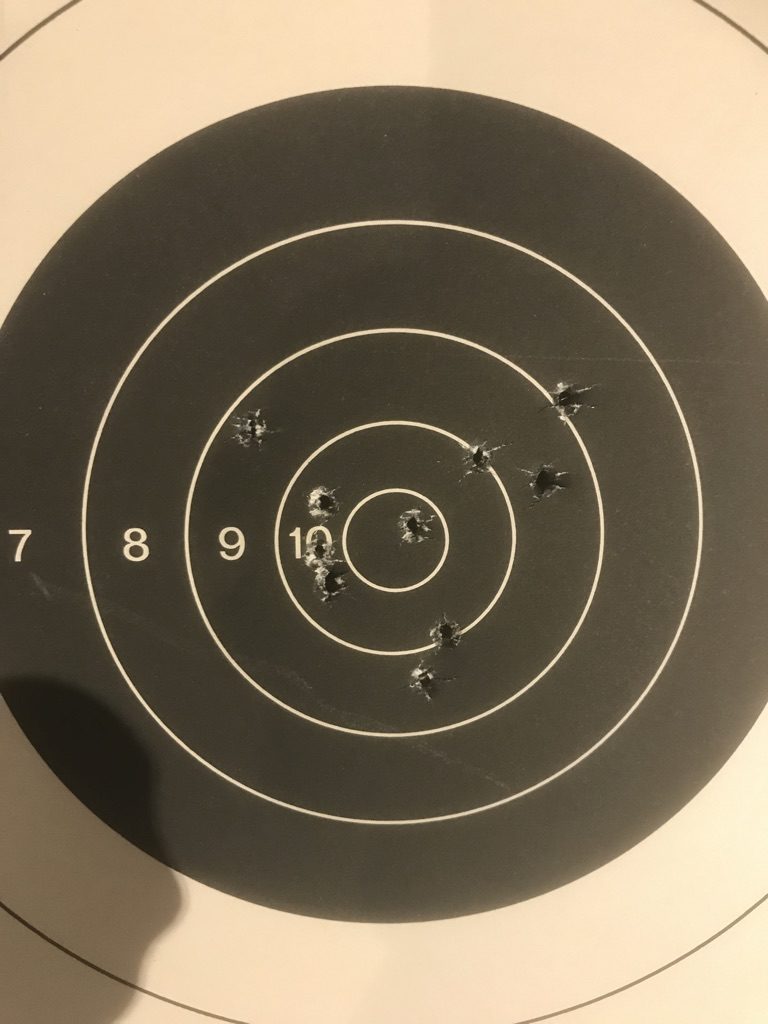
For the NMC timed fire I chose to stay with the ring #4 and it was a mistake. It was very difficult to acquire the target and I had to abort the shot a few times (see the excellent Tony Brong’s post about aborting sustained fire). The result was a catastrophic 91 with no X’s. So I switched to a larger aperture (#3) and it did improve the situation a little bit but required a lot more concentration. I was not able to clean any short line target and my sustained fire scores were between 95 and 98. And this was with .22, so I’m sure I will have even more hard time with .45.
The end result was 861-22x, which is a pretty darn good score for me and only few points less than my personal best! The downside of it is that it required a lot more work and my muscles still ache 🙂 Or is it actually a good thing? I can’t say for sure :)))
So overall I’m very happy with these rings, although I found rings #2, 5 and 6 are somewhat less useful.
Finally, here’s a list of my recommendations to PhotoEscape on how to improve the product:
- Probably the most important one – a single page of instructions, if possible, with some pictures, would be great. Also, a matrix of known supported red dot sights, thread sizes and adapter rings would be very useful.
- Offer an ability to purchase individual rings à la carte instead the entire set.
- A nice add-on would be a set of press-fit adapters of various diameters for the Aimpoint-Micro-like red dots. PhotoEscape makes set of shades for Aimpoint Micro – are they compatible with this apertures set?
- Perhaps the aperture rings should be marked somehow, either numbered or the aperture diameter indicated, this will help those shooters who keep their shooting journals and take notes.
- Finally, like I said, finish can be better on these rings, but it’s no big deal at all.
UPDATE: Alex provided his comments via email:
Comments.
- As I mentioned in message you are much better shooter than I, and were able to start from the point that took me quite a bit of time to get to;
- Because of that your were able to start from (based on your numbering) from ring #4. That is exactly correct ring for 25Y mark. Indeed one should see bullseye plus some of the next white scoring ring of the scaled down SF or full size RF/TF targets.
- Rings were machined based on Ultradot’s thread sizes. As I mentioned Ultradot at one point reversed position of the threads, and that necessitated machining of that trim ring you had to dig out from storage.
- Yes, rings #1&2 (you can see it by color) were added to the set at later time pursuing two objectives – a. to deal with Ultradot’s thread positioning inconsistencies. These two have pretty much same IDs as two Rubber Band Rings I machined (so your solution was spot on!), so they re interchangeable; b. when I started shooting with 0.500″ ring RF/TF I could not find dot between shots. Same as in your case, using plus one size up ring was my solution during acclimation period.
- In conjunction with above as you acclimate more, and muscle sourness gone, there is a good chance that you’ll change back to smaller ring even for RF/TF. And you are absolutely correct, – larger calibers will require more time to acclimate to while shooting with aperture rings.
- Color of the aperture rings is irrelevant as long as it is not clear aluminum and doesn’t create a glare and reflection. That is why two smallest rings are black, – I wanted to confirm the above. You also can correlate the above to Jon E’s review. All rings in 2nd batch will have red color.
Answers.
- Instructions. My take on this is that instructions must be limited to the “Rubber Band Ring goes on the back toward the shooter, and Aperture Rings go to the front of the dot facing target.” This product IMO must be intuitive for precision shooters, so I didn’t want to overwhelm each shooter with cookie cutter “road map”. I believe, your experience is in line with above.
- In the future I can envision offering individual rings for someone who previously purchased full set and want particular rings for other dots. I shoot two guns – 22 and 45 for CF and 45 courses. Both guns have own rings. However I reluctant to offer individual rings from get go. It is not driven by financial interest, but rather by the fact that someone, who orders i.e. #4 will through it out after first trial because of being unable to find dot between shots. I believe, acclimation process with moving from larger ID to smaller one, and finding ones that are fit each individual’s parameters/eyesight is a must!
- All rings are threaded with Ultradot’s “big” and “small” threads. I standardized on these because many shooters (including myself) have them, and can purchase additional accessories (tubes, trim rings) directly from Ultradot at prices that I cannot touch. Subsequently my shades for Aimpoint H1 Micro and reduced shades for 9000SC have correct threads and allow for the installation of rubber band and aperture ring.
- In order to deal with Ultradot’s inconsistencies, and also to adopt rubber band rings to other dots I’m in the process of machining various trim rings that will convert one size of the thread to compatible with my rings. One of the early adopters is going to contact Jon Shue, and hopefully connect us. I’ll be happy to collaborate with Jon to adopt rings to his shades. Fred Toots shades don’t have ID threads, so this is amiss.
- Interestingly enough I see no positive value in marking rings. It rather adds a negative value, as any machining process adds cost, and engraving is not different. I agree that finishing can be better. Unfortunately I have no control over the anodizing, it is farmed out.
Clarifications.
- I selected IDs for rings based on several parameters, – distance to the target, light conditions, my own individual eyesight, etc. When you switch to trying rings at 50Y, I can confidently say that #5 will be the one you chose. On the same note someone shooting indoor at 50′ will most likely use #3 for Slow and #2 for RF/TF.
- #6 ring is somewhat experimental. Jon Eulette mentioned briefly in his review possibility to use aperture rings like iron sight. When I teach at Appleseed, I call it “pumpkin on the post”. One can put dot on the back of the aperture ring (as opposed to on target) while positioning aperture over target’s bull’s eye with 6 o’clock hold. So both #5 & #6 are for 50Y (I also shoot 100m with #6), and both can be used for mimicking front iron sight.
Hi Eugene,
Now that 2 years has gone by, would you purchase these again?
Thank you.
Michael Malerba
Definitely yes, I really like how they change my sight picture.